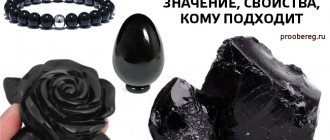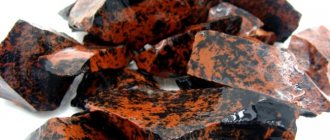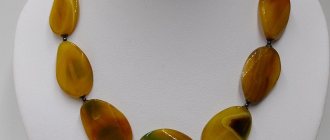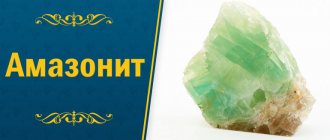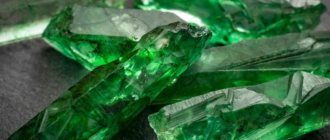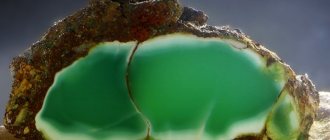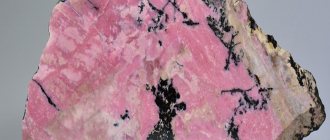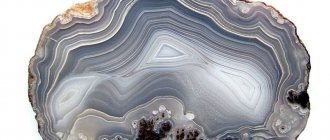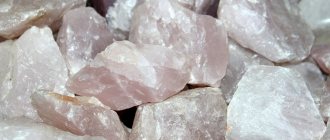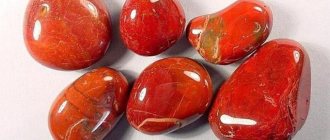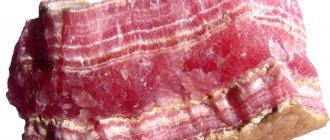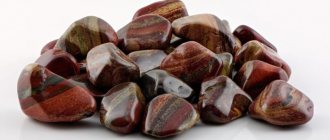Snow obsidian is one of the most beautiful, unusual minerals, possessing the most powerful energy, having the ability to influence a person’s life, making him strong, wise and lucky. Jewelry with this nugget attracts the attention of even the most sophisticated people in this matter.
A black mineral with white inclusions that look like a scattering of many snowflakes - one of the best minerals that nature has created
Snow obsidian - origin of stone, deposits
Obsidian is a volcanic glass that is formed by the rapid cooling of hot lava flows. The unusual pattern is white inclusions, similar to snowflakes, this is the result of the presence of cristobalite crystals in the mineral.
The mineral received its name in honor of the ancient Roman warrior Obsidian, who brought it to Rome, making it incredibly popular there.
Over time, the nugget gradually became famous throughout Europe.
Nugget deposits:
- Saxony;
- Japan;
- Peru;
- USA;
- Ecuador;
- Siberia, Kamchatka, Kuril Islands;
- Mexico;
- Armenia;
- Ethiopia;
- Iceland.
In different countries, the mineral is known under different names: “luxury sapphire”, “royal agate”.
Jewelry made from an unusual volcanic mineral is an ideal gift for people who, it would seem, are already difficult to surprise with jewelry. Moreover, it is not just a decoration, it is a powerful amulet for good luck.
Such jewelry will surprise even the most sophisticated people.
Healing and magical properties
The magical properties of snow obsidian have been known since ancient times. Not a single ritual of magicians and healers was complete without the participation of the mineral.
Magic properties:
- cleanses the aura;
- protects against damage and the evil eye;
- protects from evil spirits, from external influences of negative energy;
- helps make the right decisions in difficult situations;
- keeps its owner from doing wrong things that could have negative consequences;
- improves character, eliminating traits such as anger, envy, aggression.
The volcanic mineral increases attention and concentration, clears consciousness and sharpens the mind.
This is a wonderful talisman for scientists and students. It is not for nothing that in ancient times it was used to make writing instruments.
A ball made of black volcanic rock is recommended to be placed on the tables of scientists and people whose work requires mental acuity, increased attention and maximum concentration.
It is recommended to keep the snow obsidian ball on the table
The healing properties of the mineral have also been known from time immemorial. Powders, decoctions and tinctures were made from it, which helped cope with various diseases.
The healing effects of the nugget are multifaceted:
- prevention of colds and viral diseases;
- normalization of pressure, prevention of its sudden jumps;
- improvement of visual acuity;
- strengthening bone and cartilage tissue;
- removal of toxins and toxic substances from the body;
- Providing a positive effect on the skin - rapid healing of wounds and abrasions, elimination of local allergic reactions;
- normalization of the gastrointestinal tract;
- Obsidian is used to treat diseases of the genitourinary system.
Since ancient times, powder and tinctures of the mineral have been successfully used in the treatment of gout. There is a scientific explanation for this - the nugget is a powerful cleanser for the human body, which removes toxins and waste, while at the same time it has a strengthening effect on the skeletal system.
In case of gout, obsidian helps remove salts from the joints, inhibiting the development of the disease and significantly alleviating the symptomatic picture.
Lithotherapists do not advise constantly wearing products made from volcanic minerals.
No matter how attractive jewelry made from black mineral may be, it is not recommended to wear them all the time - the gem needs a break from the surrounding energy, otherwise it will lose its properties or begin to harm the owner.
The talisman must be removed periodically to allow the snow obsidian to rest.
Dzi beads made of agate - an ancient amulet of happiness
This Tibetan talisman has been known for over 2,500 years. Dzi agate has magical patterns in the form of eyes, stripes, geometric shapes and symbols. For Tibetans, beads made from this type of stone are a precious treasure that is kept in the royal family and passed on to descendants.
The mineral is an important and serious decoration in Tibet, used at weddings. It is used as a valuable amulet that removes bad karma, bestows blessings, and protects against illness and evil influences. Dzi agate has a positive effect on vitality, brings good luck, and promotes wealth.
Buy ORIGINAL
How to distinguish a real mineral from a fake
Black-painted glass is often passed off as volcanic rock. To distinguish a real mineral from a fake, you need to pay attention to the following characteristics:
- A natural mineral, upon careful examination, has a bright color and rich shine; a glass fake will only sparkle with the gloss of paint.
- If you hold volcanic rock in your palm and leave it there for 2-3 minutes, it will still remain cold. The glass will heat up immediately.
- True obsidian cannot have a uniform color - it will always contain various inclusions and patterns.
One of the most accurate testing methods is to immerse the mineral in clean water. If it is a fake, it will quickly lose its original color and shine. This will not happen with real obsidian.
Brief characteristics of agate types
Agate is a mineral that has a huge variety of patterns by which they are distinguished. There are many varieties of agate. They differ in pattern shape, color, inclusion of other substances, processing, origin, and have trade names. But it is the type of design that most often determines the name of a particular stone.
- Glazkovy. A type of mineral in which instead of stripes, circles have formed, resembling an eye. Very beautiful, with a wide variety of patterns that are never repeated.
- Indian or moss agate. It includes inclusions of Fe and Mg. It is mined in India, Russia, Africa, etc. The pattern of most minerals resembles moss, algae, trees and entire landscapes. The base color can be any, but the pattern itself is most often various shades of green, gray or black.
- Wood agate. The layers of the mineral alternate with tree-like dendrites. A woody pattern appears on the light surface of the stone. The first stones were found in India and were considered sacred stones.
- Bastion Gem. A variety that has sharp lines and curves, reminiscent of images of various fortresses, maps, and bastions. It has another name - fortress agate.
- Orange (fire) agate. It consists of strips with small goethite crystals, creating bright orange and red highlights. When you look at a gem, it seems that there is a fire burning inside it.
- Snow agate (frost). A variety of light colors, where there are inclusions reminiscent of winter landscapes on window glass, flying snowflakes.
- Botswana mineral or African. It is a rare and very expensive species. This is a gray or pink mineral with beautiful patterns and unique combinations.
- Lacy blue gem. This is a combination of white and blue stripes. Intertwined, they create unusual lace, reminiscent of shell flaps where a pearl grows. This type of mineral belongs to the spiritual species.
- Carnelian mineral. A combination of red and orange colors. The word "carnelian" is an old Russian word that means "pleasant to the heart." In the old days, it was believed that real carnelian should be black and red, and in the sun it would become bright like a pomegranate.
- Honey agate. A yellow-brown variety of the mineral that resembles sweet honey. It is also called “solar agate”.
- Coffee agate. Reminds me of coffee with milk. A pleasant coffee shade with simple patterns in the form of winding lines of white, coffee color.
- Landscape agate. A type of mineral where nature itself showed its artistic abilities. On sections of the mineral you can see pictures created by the magical hand of nature.
- Star agate. A variety found in England. A pattern of white small scatterings appeared on a pale brown background.
- Tibetan. For those who love the classics. Combination of white and black stripes.
- Overflow. A variety of Ural quartz, in which the stripes seem to spread across the surface in different colors. The colors are white, blue, orange, yellow and red. It is designed for making various jewelry.
- Apricot agate. A combination of beige, orange, lilac with fancy white patterns.
- Smoky agate. It comes in gray and light brown. It has a matte finish with blurry streaks.
The question arises: is it a gem or not? Despite the large number of varieties, agate is considered a semi-precious stone. The price depends on the type.
Agate tinted
Most types of agate do not have a rich color. Even in ancient times, they learned how to tint a mineral and make it much brighter. Roman craftsmen knew how to paint agate a rich black color. In Arabia, honey and sulfuric acid were used to enhance the color of the mineral. Now there are many technologies for coloring the mineral, the description of which is kept secret.
- The red color comes from iron oxide. The stone is covered with the mixture and heated to high temperatures.
- Yellow tones are also obtained using iron oxide, but use a different technology. First it is treated with hydrochloric acid, then heated. Various shades of yellow are obtained.
- Blue and cyan colors are obtained using Fe salts.
- Green tones can be obtained using chromium by increasing the temperature.
- Dragon vein agate is created by subjecting the mineral to special processing. It is heated strongly and then quickly cooled - small cracks (crackle) are obtained. The light stone is covered with dark cracks.
Gems that have been dyed are called refined. It must be remembered that the color of the mineral can be destroyed under the influence of the external environment (sun, salts, sea water). Products made from agate must be stored carefully.
Snow obsidian as a talisman for different zodiac signs
Obsidian shows selective attention to the signs of the Zodiac. Who does the mineral favor:
- Capricorns - volcanic glass is ideal for them. Capricorns have incredibly powerful fortitude, and therefore only they can cope with the power of obsidian.
- Aquarius and Gemini, Pisces - the gem will make them more purposeful, increase self-confidence, and help them achieve their goals faster and easier.
- Aries, Sagittarius and Leo - they can wear obsidian, which will help them gain confidence and endurance, and cope with their emotions.
- Scorpios - for them the mineral is a strong protective amulet; it is especially useful for people whose professions are associated with risks and danger.
Cancer and Virgo are the ones for whom contact with obsidian is categorically not recommended.
Even if they wear it as jewelry for a short time, it will be enough for them to feel its negative effects.
Volcanic rock makes people cautious, forcing them to think ahead about every step. And Cancers and Virgos, who already carefully avoid rash actions, risk becoming extremely unsure of themselves and their strengths; any step they take will be accompanied by eternal doubts.
Cancers and Virgos should not wear such jewelry
Who is it suitable for?
The unusual appearance very often attracts the attention of very different people, but alas, the properties of the snow obsidian stone are not suitable for everyone.
By profession
He can best help people whose work or field of activity requires perseverance and attentiveness:
- scientists;
- investigators;
- dispatchers;
- students, etc.
Zodiac sign
As mentioned earlier, the stone is not suitable for everyone, and the signs of the Zodiac are no exception:
- Favorites - Aries, Leo, Sagittarius and Capricorn.
- Cannot be worn - Virgo, Cancer. He will endow them with arrogance and inconstancy, which will instantly have a negative impact on life.
All other signs can be worn without much fear, but you won’t be able to feel any special influence.
Interesting facts about the stone
Obsidian is an amazing, mystical mineral that has always been shrouded in an aura of mystery. Interesting facts about the gem:
- According to one legend, men from the Apache tribe, who did not want to submit to the colonists, threw themselves into a volcanic crater. Their widows mourned them for several days, and on the third day, instead of tears, black minerals began to fall from their eyes. Therefore, obsidian is known in America as “Apache tears.”
- Obsidian helps to cope with bad habits (smoking, alcoholism), of course, provided that the person himself wants it.
- The volcanic rock has long been considered the protector of sailors, warriors and all those who face a long journey. Today, the black mineral is used as an amulet by pilots and flight attendants, and not only as jewelry, but also for cigarette cases, tie clips, lighters, and any small items that you can always carry with you.
- In folk medicine, volcanic glass is used in the treatment of viral and colds.
Obsidian is a powerful mineral that connects its owner with protective spirits. This is not only a beautiful decoration, but also protection from the evil eye, damage, an amulet for good luck, a talisman that promises success in all endeavors.
Myths, legends, history
Obsidian is a volcanic glass formed by the rapid cooling of lava. Obsidian was very popular early in human history. It was widely used to make knives, spears, arrowheads, mirrors and decorative objects. In the ancient culture of Mexico, this stone was called Itzli "(Itzli, literally Itzli - “Knife”. God of the stone knife for sacrifice in Aztec mythology. Servant or hypostasis of the god Tezcatlipoca (Tezcatlipoca, translated as “shining mirror”).
Obsidian was widely used in pre-Columbian Mesoamerica. It was used not only as tools, but also for decorative purposes.
Other Native American cultures used this stone in rituals to sharpen inner vision. There is a legend about the “Tears of the Apaches” associated with the warriors of the Apache tribe. According to this legend, after defeat in the war and the death of many brave warriors, Apache women mourned their men. Their tears hardened and turned into this stone.
In ancient times, Pliny wrote that obsidian got its name from a man named Obsidius, who discovered it in Ethiopia.
